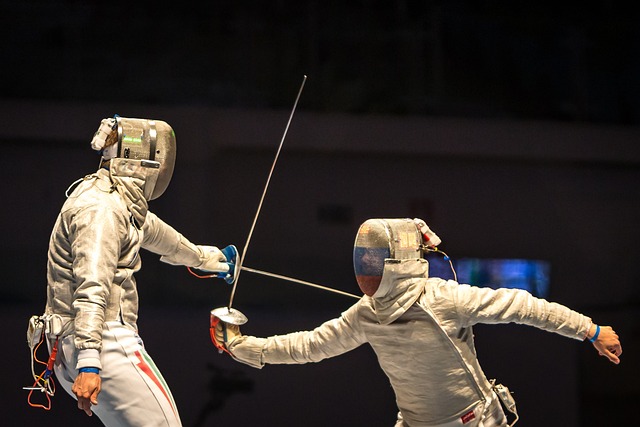Kendo is a Japanese martial art with bamboo swords (shinai), while fencing is a European sport with foil, épée, or sabre weapons. Different techniques, rules, and cultural origins.
TL:DR Kendo Vs. Fencing
Kendo, which translates to “Way of the Sword,” originated in Japan and is deeply rooted in the country’s samurai traditions. It focuses on disciplined swordsmanship and the cultivation of one’s character.
Fencing has its origins in Europe, particularly in Italy and France. It evolved from the art of dueling and developed into a sport. Fencing involves the use of three weapons: foil, épée, and sabre.
What is Kendo?

Discovering the fascinating world of Kendo begins with understanding its roots and essence. Delving into the history and origins of this ancient martial art, exploring the intricate equipment and gear utilized, and unraveling the techniques and rules that govern the practice, we uncover the enthralling dimensions of Kendo. Prepare to be immersed in a journey that uncovers the essence and beauty of this time-honored discipline.
History and Origins of Kendo
Kendo has a rich history and origins that trace back to ancient Japan. This martial art and competitive sport originated from the samurai’s practice of swordsmanship.
The roots of kendo can be dated back to the 16th century, a period of peace in Japan when samurais aimed to refine their combat skills through rigorous training.
During this time, the practice of kendo became essential. A strict prohibition against carrying real swords in public led to the use of wooden swords called “bokken” for training purposes. The samurais emphasized discipline, spiritual development, and the cultivation of martial virtues.
Kendo continued to evolve in the late 18th century with the introduction of armor called “bogu” and bamboo swords known as “shinai.” This transformed kendo from a purely practical combat practice to a more refined and competitive sport.
Today, kendo is practiced worldwide, with organizations dedicated to its preservation and promotion. The emphasis on respect, discipline, and personal growth remains integral to kendo. Regular tournaments and competitions provide opportunities for practitioners to showcase their skills and compete for rankings.
Fact: In 1952, the All Japan Kendo Federation was established to unify and standardize the practice of kendo in Japan.
Kendo Equipment and Gear
| Kendo Equipment and Gear | Description |
| Shinai | A bamboo sword used in practice and sparring. It consists of four slats of bamboo held together by leather. The shinai allows for safe and controlled strikes. |
| Bogu | Refers to the protective armor worn in kendo. It includes a men (head protector), kote (gauntlets), tare (waist protector), and do (chest protector). The bogu is designed to protect the practitioner from strikes during training and matches. |
| Gi | A jacket worn during kendo practice. It is typically made of cotton and provides comfort and mobility during training. |
| Hakama | A pleated skirt-like garment worn during kendo practice. It is made of cotton and provides freedom of movement. |
| Tare | The waist protector component of the bogu. It consists of multiple layers of fabric and is worn to protect the lower body from strikes. |
In kendo, Kendo Equipment and Gear play a vital role in ensuring the safety and effectiveness of training. The shinai allows practitioners to practice strikes with a simulated sword, while the bogu provides necessary protection from strikes during sparring sessions. The gi and hakama provide comfort and freedom of movement during practice. The tare, one of the components of the bogu, protects the lower body from strikes.
Fact: The use of protective Kendo Equipment and Gear in kendo is crucial as it allows practitioners to safely engage in intense and dynamic training sessions, enhancing their skills and ensuring their well-being.
Kendo Techniques and Rules
- Kendo Techniques:
- Men: This is a strike to the head, which is the primary target area in kendo.
- Kote: This is a strike to the wrist or forearm.
- Do: This is a strike to the torso, specifically the sides.
- Tsuki: This is a thrust to the throat.
- Kendo Rules:
- Etiquette: Respect and proper behavior are crucial in kendo. Bowing, showing respect to opponents and instructors, and following protocol are important aspects.
- Target Areas: As mentioned earlier, the head, wrists or forearms, torso, and throat are the designated target areas in kendo.
- Scoring System: Points are awarded based on the correctness of strikes. A clean strike to the target area with correct form and spirit earns a point.
- Protective Gear: Kendo practitioners wear protective equipment including a helmet (men), body armor (do), gloves (kote), and a throat protector (tsuki-dare).
- Rounds and Matches: Kendo matches are typically divided into three rounds. The first person to score two points or the person with the highest score after three rounds wins.
In kendo, both Kendo Techniques and Kendo Rules play a vital role. Techniques such as strikes to the head (men), wrist/forearm (kote), torso (do), and throat (tsuki) are practiced with precision and discipline. The rules of kendo emphasize etiquette, respect, and proper behavior. The designated target areas for scoring points are the head, wrists/forearms, torso, and throat. Protective gear, including a helmet (men), body armor (do), gloves (kote), and a throat protector (tsuki-dare), is worn during matches. Points are awarded based on the correctness of strikes, and matches are typically divided into three rounds. The winner is determined by the first person to score two points or the person with the highest score after three rounds. Kendo techniques and rules truly reflect the values of discipline, respect, and focus in this traditional Japanese martial art.
What is Fencing?

Fencing, a thrilling martial art with a rich history and a set of unique techniques and rules. In this section, we will dive into the essence of fencing, exploring its origins, the equipment and gear involved, and the techniques and rules that make it such an exciting and competitive sport. Get ready to immerse yourself in the fascinating world of fencing, where quick reflexes, strategic maneuvers, and precision are key to success.
History and Origins of Fencing
Fencing, a centuries-old sport, has a rich history and origins dating back to ancient times. It evolved from the practice of combat and self-defense techniques, with the earliest records of fencing being found in ancient Egypt over 4,000 years ago. Fencing gained popularity among European nobility during the Renaissance period, eventually becoming a competitive sport.
In the 18th century, fencing became more standardized, with rules and techniques established to ensure fairness and safety. Fencing schools, known as academies, began to emerge, and the sport continued to grow in popularity. Fencing was included in the first modern Olympic Games in 1896 and has remained a prominent sport in the Olympic program ever since.
The history and origins of fencing can be traced back to the need for swordsmanship skills in warfare and dueling. As firearms became more prevalent, fencing transitioned from a martial art to a sport focused on athleticism, strategy, and technique. Today, fencing is practiced by individuals of all ages for both recreational and competitive purposes.
In the 19th century, a French fencer named Baron Pierre de Coubertin was inspired by the spirit of fencing’s competition and sportsmanship. He believed that the principles of fencing could be applied to the modern Olympic Games and worked diligently to revive the Olympic movement. Coubertin’s efforts led to the establishment of the International Olympic Committee and the reintroduction of the Olympic Games in 1896. The rich history and origins of fencing contribute to its status as one of the most thrilling and respected Olympic sports, thanks to the passion and dedication of individuals like Baron Pierre de Coubertin.
Fencing Equipment and Gear
The fencing equipment and gear are essential for ensuring the safety and performance of the fencers. In the table below, you can find all the relevant information about each item:
| Equipment | Description |
|---|---|
| Fencing Mask | Protective headgear with a wire-mesh faceguard. |
| Jacket | Padded, long-sleeved garment for torso protection. |
| Plastron | Underarm protector worn beneath the jacket. |
| Fencing Glove | Reinforced glove to protect the weapon hand. |
| Fencing Foil | A lightweight, flexible sword used for foil fencing. |
| Épée | Heavier sword with a larger guard used in épée. |
| Sabre | A light, cutting weapon with a curved guard. |
| Body Cord | Connects the weapon to the scoring system. |
| Lame | Electrically conductive jacket for scoring. |
| Electric Scoring System | Detects touches for electronic scoring. |
Fencing Techniques and Rules
When engaging in the sport of fencing, it is crucial to familiarize yourself with various fencing techniques and rules. These guidelines will help you perform at your best and ensure a fair and safe competition.
To start a fencing match, assume the en garde position. Stand with your feet shoulder-width apart, knees slightly bent, and extend your sword arm in front of you.
Footwork plays a vital role in fencing. Learn fundamental movement techniques like advances, retreats, and lunges. These footwork techniques enable you to swiftly move in and out of range.
Fencing incorporates offensive and defensive moves. Practice different attack techniques such as the straight thrust and the disengage. Also, master defensive maneuvers like the circular parry and the beat, which are valuable in defending against your opponent’s attacks.
In fencing, priority, or right of way, determines which fencer scores when both fencers hit each other simultaneously. The fencer who initiates the attack has the right of way, while the other fencer must counter-attack or defend.
Scoring in fencing is based on valid hits called touches. A hit is scored when the tip of the sword lands on the target area with the required amount of force. Each target area has its own scoring values.
Fencing bouts are subject to time limits, typically three minutes per round. Scoring touches within this time frame is crucial; otherwise, you risk losing the match.
Safety is a priority in fencing. Fencers must wear protective gear like a mask, jacket, and gloves to prevent injuries. Additionally, fencers must adhere to specific safety rules, such as avoiding targeting the opponent’s head or below the waist.
When participating in fencing, it is essential to understand and follow these techniques and rules. Regular practice and guidance from experienced coaches will help improve your fencing skills. Remember, while technique and strategy are crucial, displaying proper sportsmanship and respect for your opponent are equally important in the world of fencing.
Key Differences Between Kendo and Fencing
When it comes to the art of combat, Kendo and fencing may seem similar at first glance, but they couldn’t be more different. Let’s unravel the key differences between these two disciplines. We’ll explore the weapons used, the target areas, the scoring system, the protective gear, and even the cultural significance. Prepare to be astounded by the contrasting worlds of Kendo and fencing, where the clash of blades takes on unique and captivating forms.
Weapons Used
Below is a table comparing the weapons used in Kendo and Fencing:
| Kendo | Fencing |
| Shinai (bamboo sword) | Foil |
| Bōgu (protective armor) | Epee |
| — | Sabre |
In both Kendo and Fencing, specific weapons are utilized for practice and competition. Kendo practitioners use a Shinai, which is a bamboo sword, to ensure secure and controlled strikes. Meanwhile, Fencing involves different weapons depending on the discipline. Foil, commonly employed in traditional Olympic fencing, emphasizes precise thrusting techniques. Epee, another weapon in fencing, features a larger and heavier blade suitable for both thrusts and cuts. On the other hand, Sabre, the third weapon used in fencing, is primarily designed for cutting attacks and has a curved blade.
Apart from the weapons themselves, another key consideration for individuals interested in practicing Kendo or Fencing is understanding the differences in combat styles and techniques associated with each weapon. Personal preferences and cultural interests may also influence the choice between these two disciplines.
Pro-tip: When deciding between Kendo and Fencing, carefully evaluate the specific combat techniques and styles associated with each weapon.
Target Areas
The target areas in both Kendo and Fencing play a crucial role as they define the body parts that can be targeted during a match. Kendo, for instance, designates the head (men), wrists (kote), body (do), and throat (tsuki) as its target areas. Each target area has its own point system, with the head being the most valuable for scoring.
On the other hand, the target areas in Fencing vary depending on the weapon used. In foil fencing, the target area is limited to the torso, including the back and front, but excludes the arms, head, and legs. In epee fencing, however, the target area encompasses the entire body, including the arms, head, and legs. As for sabre fencing, the target area extends to the entire upper body, including the arms, head, and torso.
These differences in target areas reflect the distinct rules and strategies employed in each martial art. Kendo prioritizes accuracy and precision by emphasizing specific areas to strike. On the contrary, Fencing allows for a wider range of target areas, promoting quick and agile movements.
Although both Kendo and Fencing involve targeting specific areas to score points, they differ in terms of target areas and rules. Each martial art has its unique approach to scoring in line with its principles.
Scoring System
The scoring system, which is an important component of both Kendo and Fencing, plays a significant role in determining the outcome of a match in these martial arts. Below, you will find a table that outlines the scoring system used in each sport:
| Kendo | Fencing |
| Points are awarded for strikes made with the shinai (bamboo sword). | Points are awarded for touches made with the epee, foil, or sabre. |
| A successful strike to the head or body is awarded one point. | A touch made on the opponent’s valid target area is awarded one point. |
| A strike to the wrist or throat is awarded two points. | A touch made on the opponent’s target area with a specific technique is awarded two points. |
| A strike to the side of the body is awarded two points. | A touch made on the opponent’s back or side is awarded two points. |
| No points are awarded for strikes made to the arms, hands, or legs. | No points are awarded for touches made outside the valid target areas. |
It’s important to note that the scoring system in both Kendo and Fencing is based on precision, timing, and technique. Judges or electronic scoring systems are used to determine the validity of each strike or touch. This system ensures a fair and accurate assessment of the competitors’ skills and allows for a clear determination of the winner in each match.
In summary, both Kendo and Fencing have their unique scoring systems that play a significant role in determining the outcome of a match.
Protective Gear
The protective gear used in both Kendo and Fencing is crucial to ensure the safety of the participants. Here is a list of the protective gear used in each sport:
- Kendo:
- Kendo Men: A helmet-like headgear that covers the entire head and protects the face, ears, and neck.
- Kote: Gloves that cover the hands and forearms.
- Do: A chest protector that covers the torso.
- Tare: A waistband that protects the lower abdomen.
- Tsuba: A handguard that fits over the handle of the bamboo sword to protect the hands.
- Fencing:
- Fencing Mask: A protective gear that covers the face and head.
- Plastron: A padded garment worn underneath the fencing jacket to protect the torso.
- Fencing Jacket: A jacket made of a thick material that covers the upper body and arms.
- Glove: A specialized glove that protects the hand holding the weapon.
- Underarm Protector: A padded garment worn underneath the jacket to protect the underarm.
It is important to ensure that the protective gear is properly fitted and in good condition to provide maximum safety during practice or competitions.
Similarities Between Kendo and Fencing
Although Kendo and Fencing are distinct martial arts with unique characteristics, they also share several similarities:
- Weapon-based Combat: Both Kendo and Fencing are combat sports that involve weapon-based techniques. Kendo utilizes a bamboo sword called a shinai, while Fencing uses a foil, epee, or sabre.
- Focus on Technique: Both disciplines emphasize the importance of proper technique. Practitioners of Kendo and Fencing strive to master precise and efficient movements to outmaneuver their opponents.
- Protective Gear: Both Kendo and Fencing require practitioners to wear protective gear to ensure safety during practice and competition. This typically includes helmets, masks, padded clothing, and gloves to protect the head, face, and body.
- Competitive Nature: Kendo and Fencing are competitive sports that involve one-on-one bouts. Participants aim to score points by striking their opponent while adhering to specific rules and regulations.
- Strategy and Tactics: In both Kendo and Fencing, strategy and tactics play a crucial role. Practitioners must anticipate their opponent’s moves, analyze their weaknesses, and employ various techniques to gain an advantage during the match.
- Mental Focus: Both disciplines require practitioners to have mental focus and concentration. Quick reflexes, decision-making skills, and the ability to adapt to changing situations are essential in both Kendo and Fencing.
- Training and Discipline: Kendo and Fencing demand dedicated training and discipline from practitioners. Regular practice, physical conditioning, and adherence to a code of ethics are vital for skill development and personal growth.
- International Competitions: Both Kendo and Fencing have international competitions where practitioners from different countries showcase their skills and compete for medals and titles.
- Respect for Tradition: Kendo and Fencing have a strong emphasis on tradition and etiquette. Respect for opponents, instructors, and the history of the martial art is an integral part of the training and competition experience.
While there are similarities between Kendo and Fencing, it’s important to recognize and appreciate the unique aspects and cultural contexts of each martial art.
Which One Should You Choose: Kendo or Fencing?
Choosing between Kendo and Fencing depends on your personal preferences and goals. Consider the following factors to make an informed decision:
- Weapon and Style: Kendo involves the use of a bamboo sword called a shinai and focuses on strikes to specific target areas. Fencing, on the other hand, uses a flexible sword with a blunted tip and emphasizes thrusting and parrying techniques. Consider which weapon and style resonate with you more.
- Cultural Background: Kendo originated in Japan and has deep cultural roots, often incorporating elements of Japanese etiquette and philosophy. Fencing has European origins and is influenced by Western traditions. If you have a particular interest in one culture over the other, it may sway your decision.
- Physical Demands: Both Kendo and Fencing require agility, coordination, and quick reflexes. Kendo typically involves more full-body movements, including footwork and striking with the entire body. Fencing tends to focus on quick footwork and precise hand movements. Consider which physical demands align with your abilities and preferences.
- Competitive Aspect: Both Kendo and Fencing offer competitive opportunities at various levels, from local tournaments to international championships. Research the competitive scene in your area and assess which sport offers the level of competition you desire.
- Training and Equipment: Consider the availability of training facilities and instructors for Kendo and Fencing in your area. Factor in the cost and accessibility of the necessary equipment for each sport, such as shinai and protective gear for Kendo, or a fencing mask and protective clothing for Fencing.
- Personal Interest: Ultimately, choose the sport that interests you the most. If you have a fascination with Japanese culture and samurai traditions, Kendo may be a natural choice. If you are drawn to the elegance and historical significance of European swordsmanship, Fencing may be the better fit.
Consider these factors and, if possible, try out introductory classes or speak with practitioners of both Kendo and Fencing to get a firsthand perspective. Ultimately, the choice between Kendo and Fencing should be based on your personal preferences, goals, and what resonates with you as an individual.
Frequently Asked Questions
What is the difference between Kendo and fencing?
Kendo and fencing are two different sword fighting styles with distinct origins and purposes. Kendo is a modern Japanese martial art that focuses on sword-fighting techniques derived from traditional Japanese swordsmanship, while fencing is a competitive sport of Western origin.
How are Kendo and fencing practiced?
In Kendo, practitioners use bamboo swords called shinai and wear protective armor known as bogu. Fencing, on the other hand, is done on a strip allowing linear motion and can be practiced with various weapons, although the most popular blades used are foil, epee, and saber.
Are Kendo and fencing effective for self-defense?
Neither Kendo nor fencing are effective for self-defense in real-life situations where assailants may be armed with deadly weapons. While martial arts knowledge can be beneficial in certain circumstances, the techniques taught in Kendo and fencing do not necessarily translate to chaotic and intense real fights.
What are the main focuses of Kendo and fencing?
Kendo is not only a competitive sport but also a budō, which is a way of elevating oneself spiritually. Fencing, on the other hand, is primarily a rules-based sport focused on technique and defense, with participants showcasing their physical dexterity.
Can Kendo and fencing be used against street fighters or assailants with deadly weapons?
Kendo and fencing techniques are not specifically designed or taught to be used against street fighters or assailants armed with deadly weapons. However, having knowledge of martial arts can still be beneficial, and improvised weapons like sticks or poles can be used effectively in self-defense situations.
What are the origins of Kendo and fencing?
Kendo originated in Japan as a descendant of traditional Japanese swordsmanship known as Kenjutsu. Fencing, on the other hand, originated in Europe, with its roots tracing back to the swordplay of the Italian Renaissance and the dueling traditions of the Spanish Empire.
Image Credits
Featured Image By – Pexels from Pixabay
Image 1 By – Photo by Serena Koi








